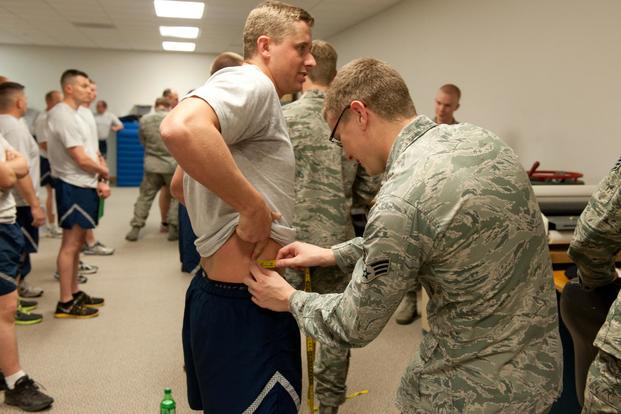NATIONAL HARBOR, Maryland -- The U.S. Air Force is considering administering the abdominal circumference test at a separate time from the rest of the physical fitness assessment in order to prevent added body stress and unwanted injuries, according to the service's top enlisted leader.
Chief Master Sergeant of the Air Force Kaleth O. Wright told audiences here during the annual Air, Space and Cyber Conference that the service is weighing administering the measurement, known as the tape test, at least seven days apart from the pushups, sit-ups and run components of the PT test.
"We have airmen who go to great lengths to get a good score on the abdominal circumference ... because it counts for 20% of the test," Wright said during a speech, adding some airmen have gone to extremes, even starving themselves, to pass the waist measurement test.
"And then they try to run or do the other components, and we've had airmen who have lost their lives or have become injured," Wright said. There have been three PT-related deaths in the last five months, the most recent at Eglin Air Force Base, Florida, last month. Investigations into their deaths have not yet been released.
In June, Shaw Air Force Base in South Carolina briefly suspended all PT tests after two airmen died less than a week apart following completion of their PFAs.
Related: Read all about the Air, Space and Cyber Conference
The current Air Force fitness test is gender and age-normed and combines a 1.5-mile run time with maximum pushup and sit-up repetitions within one minute.
Wright previously told Air Force Times that the tape test and PFA, if separated, should be taken more than seven but not more than 30 days apart.
He reiterated that the service is also reviewing other changes, such as instituting a mock test.
In July, Wright's spokesman, Senior Master Sgt. Harry Kibbe, said the service began looking at the possibility of a no-fail trial PT test, that, if passed, would count as the airman's official score. The intent would be to reduce test-taking anxiety among airmen.
Wright on Wednesday said there are groups of airmen who believe that elements of the PFA should be altered or removed, and others who believe they don't need a PT test at all because they live a healthy and fit lifestyle. That will never be a reality, he said. But Wright hopes small changes will make a big difference for airmen.
Another possibility under consideration may be to modify how the service measures VO2 max, or a person's maximal oxygen uptake, which can be measured in a run time and divided by his or her waist-to-height ratio.
"One of the things we've talked about, but we haven't gotten there yet is, not everybody's a runner. And we want to be able to measure VO2 Max maybe by rowing or swimming or cycling," Wright said.
"So we'll keep you updated as we conduct [these] tests, and as we get the right approvals and right system. But I would like for us as an Air Force to start thinking about what health and fitness means [which] is not just a test; Being healthy ... comes from you living a lifestyle of fitness 365 days a year," he said.
-- Oriana Pawlyk can be reached at oriana.pawlyk@military.com. Follow her on Twitter at @oriana0214.












